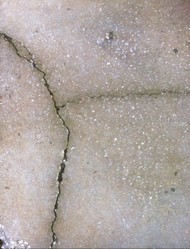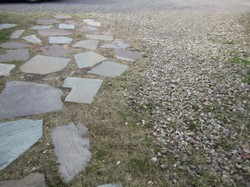Key the Crack
With a hammer drill or small sledge and masonry chisel, reshape the crack so the bottom is wider than the top. This is called “keying”. Keying helps anchor the patching material. You would then chisel out any loose or weak spots also. If the crack is deeper than ½ inch, paint it with a bonding adhesive made by the same company that manufactures the patching compound you will be using. Let it dry thoroughly before applying the patch.

Repairing a Concrete Subfloor
by BobVicars
Fixing large and small cracks is one of the most basic and simple repairs you can make as a home owner. The tips below are easy to do.
Key the Crack
With a hammer drill or small sledge and masonry chisel, reshape the crack so the bottom is wider than the top. This is called “keying”. Keying helps anchor the patching material. You would then chisel out any loose or weak spots also. If the crack is deeper than ½ inch, paint it with a bonding adhesive made by the same company that manufactures the patching compound you will be using. Let it dry thoroughly before applying the patch.
Patch the Crack
On cracks up to about ½ inch deep, trowel in a vinyl concrete patch. Mix according to the directions on the bag or pail, and trowel a ¼ layer into the crack. If more layers are necessary, let the patch dry according to the manufacturer’s recommendation before applying a new layer. Trowel the final layer smooth and flush.
Filling Deep Cracks
On deeper cracks, prepare some sand mix according to the directions on the bag. Trowel it into the crack, filling it flush with surface. When the sheen dries off the surface, work the patch so it matches the rest of the concrete. If the existing surface is slightly porous, smooth the surface with a wooden float. If the existing concrete is very smooth; even out the surface with a metal finishing trowel. If the surface is covered with swirls, pull a whisk broom across the patch.
Fixing a small crack
Blow dust from the crack with a shop vacuum or air compressor. If the crack is deep, fill it partially with sand, leaving a space about ¼ to ½ inches deep. Squeeze some crack sealer into the opening until it forms a layer ¼ inch deep. Let it dry overnight, and then apply another layer. Repeat until the surface is flush with the float. Be sure not to overfill.
Following these steps are a great help in the right direction. If you fill like you over your head then please seek help with this home project. Doing a project of this size is not only easy but is more cost effective than having tradesmen perform the task. It should be noted that most masons charge approximately $100+ dollars per hour to perform this job.
You might also like
The Home Improvement Contest I Didn't Enter but WonI felt I had a chance of winning the contest for America's Most Desperate Lan...






 How to remove grout from tileon 05/04/2015
How to remove grout from tileon 05/04/2015
 Why I Don't Loan Toolson 05/02/2015
Why I Don't Loan Toolson 05/02/2015
 The Basics of Installing New Underlaymenton 04/29/2015
The Basics of Installing New Underlaymenton 04/29/2015
 The Basics of Laying Down Ceramic Tileon 04/29/2015
The Basics of Laying Down Ceramic Tileon 04/29/2015


Comments